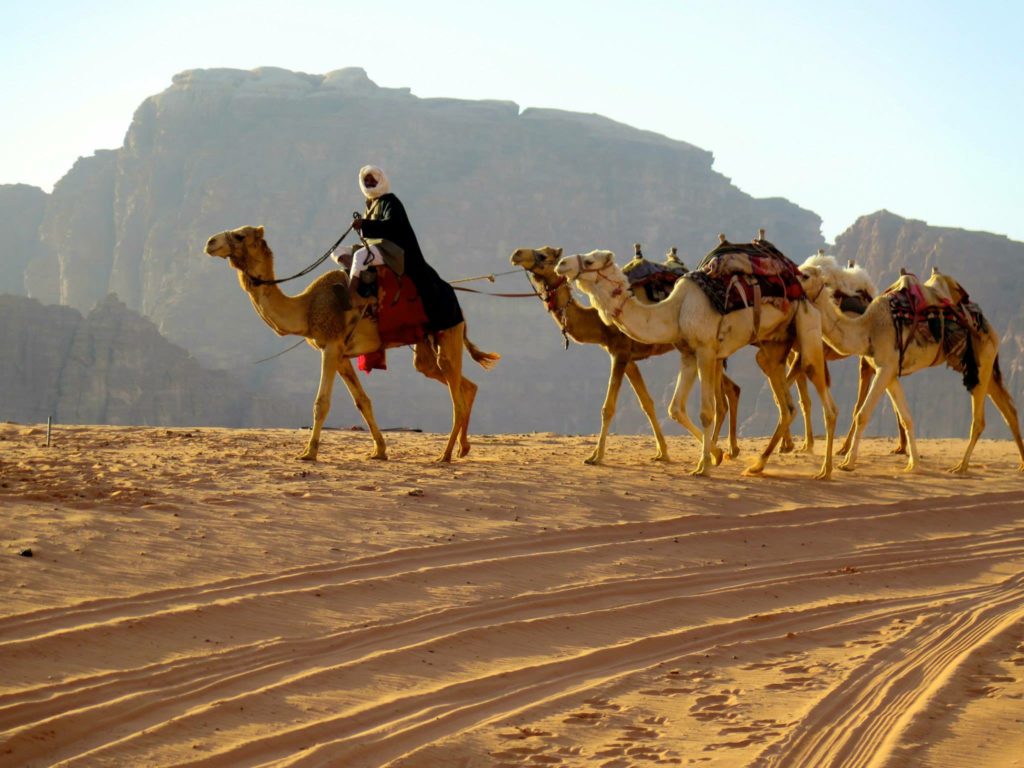[Greek] κάμηλος (kamēlos): camel, beast of burden, bearer, carrier; Mt.3:4, Mt.19:24, Mt.23:24, Mk.1:6, Mk.10:25, Lk.18:25

A Bedouin leads a caravan (herd) of camels
Background Information:
Old Testament: This refers to the Hebrew gamal, meaning bearer or carrier. The camel was the oldest and most common beast of burden in the Near East. The camel’s place of origin was perhaps in Arabia, but it was known in Babylon and Assyria. According to the Old Testament, the camel was loved by the Bedouins. It was also used by the patriarchs on their journeys. The camel, considered unclean (cannot be eaten), was primarily used for transportation. Neither they nor their camels could be numbered (Jgs.6:5). He made the camels kneed by the well outside the city (Gen.24:11). He also took the crescents that were on the necks of their camels (Jgs. 8:21). The camel which indeed chews the cud (Lev.11:4). She arrived in Jerusalem with a very numerous retinue and with camels bearing spices (1 Kgs.10:2). Wearing a hairy garment, with a leather girdle, it is Elijah (2 Kgs.1:8).
New Testament: This term appears in the Synoptic gospels. As with the Old Testament prophets, John the Baptist is found wearing camel’s cloth. In denouncing the Pharisees and scribes, Jesus makes use of a camel in a parable. Jesus use hyperbole to emphasize the impossibility of something. Jesus, making another reference to a camel, exposes the judgment and scrupulosity of the Pharisees. The Pharisee loses all sense of what is great and little in the Law.
Scripture:
“Again I say to you, it is easier for a camel to pass through the eye of a needle than for one who is rich to enter the kingdom of heaven.” Mt.19:24
Jesus uses hyperbole (exaggeration) and extreme contrasts to illustrate the difficulty of a rich man to enter into heaven. The camel is largest beast of burden. Attachment to material possession may often provide an obstacle to discipleship.
“John wore clothing made of camel’s hair and had a leather belt around his waist. His food was locusts and wild honey.” Mt.3:4
Camel’s hair is a cheap and durable garment. This garment is characteristic of simple, nomadic, and missionary lifestyle of the prophet. Zechariah wore hearing clothing. Isaiah wore a sackcloth.
“Blind guides, who strain out the gnat and swallow the camel!” Mt.23:24
Jesus again uses exaggeration to denounce the Pharisees and scribes. The Pharisee strains his drink but forgets righteous, mercy, and faith. The Pharisees loses all perspective
Conclusion:
Camel
I think we can all agree that camels were extremely important and necessary for transportation. Perhaps it was a good thing that camels were considered unclean (not to be eaten). Although I already knew that Isaiah and Ezekiel were prophets, I did not realize that they also had worn the garments of prophets. Isaiah had worn a sackcloth. Ezekiel also worn camel’s garments. It was through a recent post that I was able to find out this information.
Jesus’s parable of the camel of the eye of the needle makes more sense knowing that camels are the largest animals in Palestine. I guess it is very true in that you cannot take your “stuff” and possessions with you to heaven. You have to leave it all behind. Interestingly, this principle closely relates to Mt. 5:3. This is the first beatitude which says that kingdom of heaven is for the poor in spirit.
